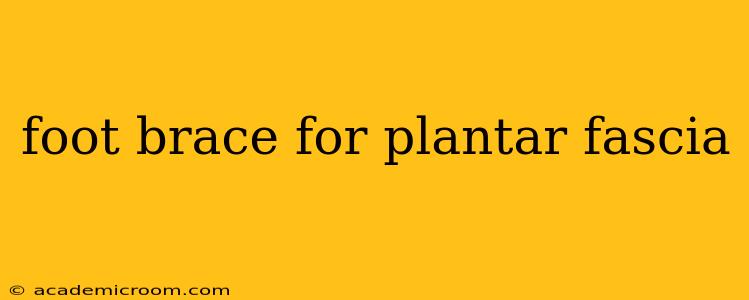Plantar fasciitis, that nagging heel pain, affects millions. Finding the right foot brace can be the key to managing this condition and getting back on your feet comfortably. This guide explores various brace types, how to choose the best one for you, and answers common questions surrounding plantar fasciitis treatment with bracing.
What is Plantar Fasciitis?
Plantar fasciitis is an inflammation of the plantar fascia, a thick band of tissue on the bottom of your foot that runs from your heel to your toes. This inflammation causes heel pain, often worse in the morning or after periods of rest. Overuse, improper footwear, tight calf muscles, and even flat feet can contribute to the condition.
What are the Different Types of Plantar Fascia Braces?
Several types of foot braces effectively address plantar fasciitis. Understanding their differences is crucial for selecting the right one:
-
Sleeves: These are simple, often sock-like coverings that provide gentle compression and support. They're good for mild cases or as a preventative measure for athletes.
-
Arch Supports: These inserts fit inside your shoes and provide support for the arch of your foot, reducing strain on the plantar fascia. They come in various materials (e.g., gel, foam, plastic) and levels of support.
-
Night Splints: These braces are worn at night to gently stretch the plantar fascia and reduce morning stiffness. They typically hold your foot at a 90-degree angle.
-
Heel Cups: These are specifically designed to cushion the heel and provide support, often incorporating a rigid shell for added stability.
-
Ankle Braces: While not solely for plantar fasciitis, some ankle braces offer supportive features that can aid in managing heel pain, especially if the problem stems from instability in the ankle joint.
How Do I Choose the Right Plantar Fascia Brace?
Selecting the right brace depends on several factors:
-
Severity of your pain: Mild pain may respond well to sleeves or arch supports. More severe pain may require heel cups, night splints, or even custom orthotics.
-
Your activity level: Active individuals may need more substantial support than those with sedentary lifestyles. A runner, for example, might benefit from a more supportive brace than someone who mostly sits at a desk.
-
Your footwear: Consider your typical footwear. Some braces are better suited for certain types of shoes. Arch supports are most effective inside shoes, while sleeves can be worn with or without footwear.
-
Your budget: Prices vary widely, so choose a brace that fits your budget while still meeting your needs.
-
Your doctor's recommendations: Always consult a podiatrist or other healthcare professional for diagnosis and treatment advice. They can help determine the best type of brace and recommend specific products.
What are the Benefits of Using a Plantar Fascia Brace?
Using a properly fitted brace can offer several benefits:
-
Pain reduction: By providing support and cushioning, braces reduce strain on the plantar fascia, leading to less pain.
-
Improved mobility: Reduced pain allows for increased movement and improved daily activities.
-
Faster healing: Braces can help accelerate the healing process by promoting proper foot alignment and reducing inflammation.
-
Preventative measure: Wearing a supportive brace can help prevent plantar fasciitis from developing in the first place, particularly for individuals at risk.
How Long Does it Take for a Plantar Fascia Brace to Work?
The timeframe for noticing relief varies depending on the severity of the condition and the type of brace used. Some people experience immediate relief, while others may need several weeks to see significant improvement. Consistency in wearing the brace is crucial for optimal results.
Can I Wear a Plantar Fascia Brace All Day?
While many braces are designed for all-day wear, it's best to follow your doctor's or physical therapist’s guidance. In some cases, it might be recommended to wear the brace only during periods of activity or at night. Prolonged use may sometimes lead to muscle weakness or dependence, so a balanced approach is recommended. Your healthcare provider can advise you on the appropriate usage schedule based on your individual condition and needs.
What Else Can I Do Besides Using a Foot Brace for Plantar Fasciitis?
Foot braces are often a part of a comprehensive treatment plan. Other strategies include:
-
Stretching exercises: Regular stretching of the calf muscles and plantar fascia helps improve flexibility and reduce pain.
-
Ice therapy: Applying ice packs to the affected area can reduce inflammation and pain.
-
Over-the-counter pain relievers: Medications like ibuprofen or naproxen can help manage pain and inflammation.
-
Physical therapy: A physical therapist can provide personalized exercises and stretches to improve strength, flexibility, and mobility.
-
Proper footwear: Wearing supportive shoes with good arch support is essential for preventing and managing plantar fasciitis.
By understanding the different types of plantar fascia braces and considering your individual needs, you can significantly improve your comfort and accelerate your recovery from this common condition. Remember to consult with a healthcare professional for personalized advice and treatment.
